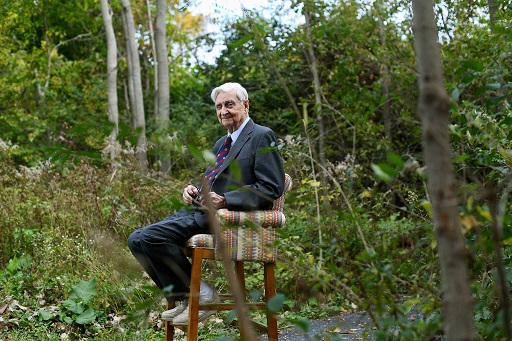 Harvard biologist Edward Osborne Wilson, sometimes described as the “father of biodiversity”, passed away yesterday. He will be missed.
Harvard biologist Edward Osborne Wilson, sometimes described as the “father of biodiversity”, passed away yesterday. He will be missed.
Wilson was a groundbreaking biologist, initially recognized for his study of ants. He authored 30 books and 430 academic papers, held 40 honorary doctorates, and was an engaging speaker. Wilson became an advocate for restoration of vast landscapes in an effort to protect the earth for future generations, opining on the value of “reweaving the wondrous diversity of life that still survives around us.”
We arranged to meet Wilson in 2016, when he came to Berkeley for a conference on the 100th anniversary of the National Park Service. He asked when “that damn dam was coming out?”. We asked if he might help. Wilson did not specifically decline but, like many academics, did not seem willing to engage in a political effort like ours.
E.O. Wilson also served as the inspiration for EDF’s Paradise Regained: SOLUTIONS FOR RESTORING YOSEMITE’S HETCH HETCHY VALLEY. EDF, like Restore Hetch Hetchy, is staunchly nonpartisan, and recruited two former California Resource Secretaries, Republican Doug Wheeler and Democrat Huey Johnson, to draft a foreword for the report. They did do, drawing on Wilson for inspiration – see below.
Foreword
More than a decade ago, the renowned Harvard biologist, E.O.Wilson, spoke of the need of repairing, where possible, the environmental damage which is an unfortunate legacy of heedless development in sensitive areas. In his seminal book, The Diversity of Life, Wilson urges that we now “go beyond mere salvage to begin the restoration of natural environments, in order to enlarge wild populations and stanch the hemorrhaging of biological wealth.”
To a remarkable extent, 21st-century Americans have taken Wilson’s updated definition of the public trust to heart, and are everywhere engaged in restoration projects small and large. Some are audacious indeed, striving to reweave and restore entire habitats on a scale as large as Florida’s Everglades, the Chesapeake Bay, and San Francisco’s Bay- Delta Estuary; others are as small as the watersheds of local, but nonetheless productive, creeks and tributaries. These projects result from the growing conviction that we have the capability, if not the obligation, to make amends for past mistakes, using newfound scientific knowledge and advanced technologies.
We think of Wilson’s words as we read this report on the development of feasible alternatives to the water supply and hydroelectricity, which are currently provided by the O’Shaughnessy Dam on the Tuolumne River in the Hetch Hetchy Valley. Almost from the time of its construction early in the last century, visionaries have argued for the restoration of Hetch Hetchy to its splendid natural condition. Perhaps they can be excused for having given short shrift to the social and economic consequences of so bold a vision: millions of northern Californians have come to depend on the water and power of the Hetch Hetchy system. Whatever one’s opinion of the merits of the original decision or of federal and state water policies as they evolved over the last century, however, no plan for the restoration of the Hetch Hetchy Valley, no matter how felicitous, can be considered without addressing this dependency on the current system.
Indeed, restoration advocates bear the burden of proving that alternatives can be made to work. In accepting this challenge, Environmental Defense, with the help of three distinguished consulting firms, has produced an extraordinarily thorough and thought-provoking assessment. As veterans of many an environmental controversy, we know that a lengthy dialog must precede any decision as momentous as the proposal to restore Hetch Hetchy and that the legitimate concerns of all stakeholders must be addressed. We welcome the publication of this report as an essential element of that dialog, coming at a time when the San Francisco Public Utilities Commission must make costly long term decisions about upgrades to its Hetch Hetchy infrastructure. It is also time, as E.O.Wilson suggests, to begin “reweaving the wondrous diversity of life that still survives around us.”
Douglas P. Wheeler and Huey D. Johnson both served as Secretary for Resources, State of California, in 1991–99 and 1978–82, respectively. Doug Wheeler presently chairs the National Park System Advisory Board and was formerly Executive Director of the Sierra Club and co-founder and President of American Farmland Trust. Huey Johnson was formerly the Western Regional Director of The Nature Conservancy and founder and President of the Trust for Public Land. He presently leads the Resource Renewal Institute.
